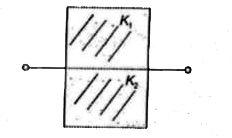A parallel plate capacitor is formed by two plates, each of area 100cm2, separated by a distance of 1 mm. A dielectric of dielectric constant 5.0 and dielectric strength 1.9X107Vm−1 is filled between the plates. Find the maximum charge that can be stored on the capacitor without causing any dielectric breakdown.
To find the maximum charge that can be stored on a parallel plate capacitor filled with a dielectric without causing dielectric breakdown, we can follow these steps:
Step 1: Convert given values to standard units
- Area of the plates, A=100cm2=100×10−4m2=0.01m2
- Distance between the plates, D=1mm=1×10−3m
- Dielectric constant, K=5.0
- Dielectric strength, E=1.9×107V/m
Step 2: Calculate the potential difference across the plates
The potential difference V can be calculated using the formula:
V=E×D
Substituting the values:
V=(1.9×107V/m)×(1×10−3m)=1.9×104V
Step 3: Calculate the capacitance of the capacitor
The capacitance C of a parallel plate capacitor filled with a dielectric is given by:
C=ϵ0⋅A⋅KD
Where ϵ0=8.85×10−12F/m (permittivity of free space). Substituting the values:
C=(8.85×10−12F/m)⋅(0.01m2)⋅5(1×10−3m)
Calculating this gives:
C=(8.85×10−12)⋅(0.01)⋅5(1×10−3)=4.425×10−10F=44.25×10−11F
Step 4: Calculate the maximum charge stored
The maximum charge Qmax that can be stored on the capacitor is given by:
Qmax=C⋅V
Substituting the values:
Qmax=(44.25×10−11F)⋅(1.9×104V)
Calculating this gives:
Qmax=83.475×10−7C≈8.3475×10−6C≈8.35μC
Final Answer
The maximum charge that can be stored on the capacitor without causing any dielectric breakdown is approximately:
Qmax≈8.35μC
---
- Area of the plates, A=100cm2=100×10−4m2=0.01m2
- Distance between the plates, D=1mm=1×10−3m
- Dielectric constant, K=5.0
- Dielectric strength, E=1.9×107V/m
The potential difference V can be calculated using the formula:
V=E×D
Substituting the values:
V=(1.9×107V/m)×(1×10−3m)=1.9×104V
The capacitance C of a parallel plate capacitor filled with a dielectric is given by:
C=ϵ0⋅A⋅KD
Where ϵ0=8.85×10−12F/m (permittivity of free space). Substituting the values:
C=(8.85×10−12F/m)⋅(0.01m2)⋅5(1×10−3m)
Calculating this gives:
C=(8.85×10−12)⋅(0.01)⋅5(1×10−3)=4.425×10−10F=44.25×10−11F
The maximum charge Qmax that can be stored on the capacitor is given by:
Qmax=C⋅V
Substituting the values:
Qmax=(44.25×10−11F)⋅(1.9×104V)
Calculating this gives:
Qmax=83.475×10−7C≈8.3475×10−6C≈8.35μC
The maximum charge that can be stored on the capacitor without causing any dielectric breakdown is approximately:
Qmax≈8.35μC
Topper's Solved these Questions
- CAPACITORSBOOK - HC VERMA ENGLISHCHAPTER - CAPACITORSEXERCISE - Objective 1
12 Videos
- CAPACITORSBOOK - HC VERMA ENGLISHCHAPTER - CAPACITORSEXERCISE - OBJECTIVE 2
6 Videos
- CAPACITORSBOOK - HC VERMA ENGLISHCHAPTER - CAPACITORSEXERCISE - short answer
7 Videos
- BOHR'S MODEL AND PHYSICS OF THE ATOMBOOK - HC VERMA ENGLISHCHAPTER - BOHR'S MODEL AND PHYSICS OF THE ATOMEXERCISE - Short Answer
10 Videos
- DISPERSION AND SPECTRABOOK - HC VERMA ENGLISHCHAPTER - DISPERSION AND SPECTRAEXERCISE - Question for short Answer
6 Videos
Similar Questions
A capacitor is formed by two square metal-plates of edge a, separated by a distance d. Dielectrics of dielectric constants K1andK2 are filled in the gap as shown in fig. Find the capacitance.

View SolutionA parallel plate capacitor is made of two circular plates separated by a distance 5mm and with a dielectric of dielectric constant 2.2 between them. When the electric field in the dielectric is 3×104V/m the charge density of the positive plate will be close to:
View Solution
Knowledge Check
A parallel plate capacitor of capacity 5μF and plate separation 6cm is connected to a 1V battery and is charged. A dielectric of dielectric constant 4 and thickness 4cm is introduced into the capacitor. The additional charge that flows into the capacitor from the battery is.
A2μCB3μCC5μCD10μC
A parallel plate capacitor is to be designed with a voltage rating 1 KV using a material of dielectric constant 3 and dielectric strength about 107Vm−1. [Dielectric strength is the maximum electric field a material can tolerate without break down, i.e, without starting to conduct electrically through partial ionization. For safety, we should like the field never to exceed say 10% of the dielectric strength]. What minimum area of the plates is required to have a capacitance of 50 pF ?
View SolutionA capacitor of plate area A and separation d is filled with two dielectrics of dielectric constant K1=6andK2=4. New capacitance will be

View SolutionThe capacity of a parallel plate capacitor formed by the plates of same area A is 0.02μF with air as dielectric. Now one plate is replaced by a plate of area 2A and dielectric (k=2) is introduced between the plates, the capacity is
View SolutionA parallel-plate capacitor has plates of area 10cm2 separated by a distance of 1mm. It is filled with the dielectric mica and connected to a battery of emf 6 volts. Find the leakage current through the capacitor. Resistivity of mica=1×1013(Ω)m.
View SolutionSeparation between the plates of a parallel plate capacitor is d and the area of each plates is A. When a slab of material of dielectric constant k and thickness t(t<d) is introduced between the plates. Its capacitance becomes
View SolutionThe plates of a parallel plate capacitor with no dielectirc are connected to a volatage source. Now a dielectric of dielectric constant K is inserted to fill the whose space between the plates with voltage source remainign connected to the capacitor-
View SolutionA parallel plate capacitor (without dielectric) is charged by a battery and kept connected to the battery. A dielectric salb of dielectric constant 'k' is inserted between the plates fully occupying the space between the plates. The energy density of electric field between the plates will:
View Solution
